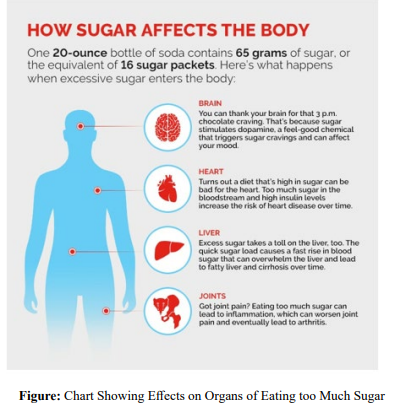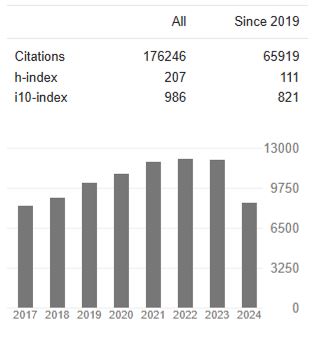Short Communication - (2024) Volume 8, Issue 2
Sweet Tooth Kids: Their Risk for Diabetes Soars During Adulthood
Received Date: Nov 01, 2024 / Accepted Date: Nov 29, 2024 / Published Date: Dec 02, 2024
Copyright: ©2024 P D Gupta. This is an open-access article distributed under the terms of the Creative Commons Attribution License, which permits unrestricted use, distribution, and reproduction in any medium, provided the original author and source are credited.
Citation: Gupta, P. D. (2024). Sweet Tooth Kids: Their Risk for Diabetes Soars During Adulthood. J Addict Res, 8(2), 01-03.
Abstract
The chronic consumption of refined sugar activates the same brain circuits as cocaine and opioids, we have yet to understand the full neurological and behavioural effects of either cocaine use or sugar consumption. the neurochemistry and the behaviour of a sugar user are strikingly similar to that of a drug user. The opinion is divided, if not addiction, it may be that sweetness or palatability is central to addictive-like eating. Eating too much simple sugar may lead to many health problems. Recently it was found that persons who consumed too much sugar in their early life in the first 1000 days of life were likely to develop type 2 diabetes or high blood pressure in adulthood, which may be due to changes in gut microbiota composition because of too much sugar consumption.
Keywords
Sugar Addiction, In Utero, Diabetes, Gut Microbiota
Introduction
There is a thin line between craving and addiction. Craving is the sign of an addiction. Craving is a powerful desire, whereas addiction is the continued use of a substance. The bodily effect wise both the phenomena are same. Individuals addicted to drugs, alcohol, or behaviours also experience other symptoms, like not being able to stick to limits, increased tolerance, and continued use despite negative consequences. Sugar has no nutritional value other than to provide empty calories. To improve the overall nutrient density of the diet and to help reduce the intake of excess calories, individuals should be sure not to displace foods with essential nutrients or increase calorie intake with food high in added sugar Addiction is a strong word not typically applied to sugar, but it can be very difficult to stop eating sugar [1]. Though it is well known that it has no nutritional value. However. the study demonstrates that the effects of sugar addiction, withdrawal, and relapse are similar to those of drugs of abuse [2,3]. Since many humans may be experiencing compulsive cravings towards sugar due to addictions they never knew existed, breaking those habits could make avoiding junk foods in the future easier than ever! .
Health Problems for Consuming too Much Sugar
Generally, consuming too much sugar, especially in the form of high fructose corn syrup, leads to serious health problems including obesity, diabetes, certain cancers, and even heart disease. All sugars are eventually broken down to the same compound, but High-fructose corn syrup (HFCS) is considered the worst because it bypasses some regulating steps inherent in the body, leading to insulin resistance, fat production, and a fatty liver (Figure). Excess sugar consumption has been associated with cirrhosis, neuropathy, kidney disease, general inflammation, and cancer [3,4]. In fact, there are several cancer links, such as breast, colon, and endometrial, that are associated with obesity, which might indirectly feed off of sugar in the diet; some tumour cells can use sugar and insulin as fuel to grow.
Eating too much simple sugar may lead to headaches in certain individuals. High blood sugar, high insulin levels, and alterations in hormones like testosterone, caused by eating too much sugar, can lead to acne. Knowing the ill effects of sugar, the American Heart Association recommends no more than 6 teaspoons (25 grams) of added sugar per day for women and 9 teaspoons (38 grams) for men. Children between 2 and 18 years old should eat less than 6 teaspoons of added sugar per day.

Recent Findings
Persons who consumed sugar as mentioned above early in life were less likely to develop type 2 diabetes or high blood pressure in adulthood than people who did not experience sugar rationing Exposure to sugar rationing in the first 1000 days of life protected against chronic disease [5]. The risk of developing diabetes among people who rationed early in life was about 62 percent of the risk experienced by those whose sugar intake was not rationed; the risk of developing hypertension among those who experienced rationing was about 79 percent of the risk of those who did not. Kids who experienced sugar rationing early weren’t immune to developing these chronic conditions, but it tended to happen later in life: four years later on average for diabetes than the nonrationed subject and two years later on average for high blood pressure. Participants were also less likely to develop diabetes and hypertension if they experienced sugar rationing in utero, even if the participants did not experience rationing after birth. Regarding sugar consumption Gracner remarked “I think we all want to improve our health and give our children the best starting life, avoiding added sugars can be challenging, especially when so many foods for both adults and young children contain them. I don’t want parents to be feeling guilty for giving their toddlers sugar sometimes [4].
Early Childhood Diet
The infant whose mother had an increased sugar intake during the dietary intervention showed the most substantial difference in gut microbiome functional potential between pre-and post-diet samples, with a general increase in the relative abundance of genes involved in most functional metabolic pathways Several studies have investigated maternal contributions to infant health [6-8]. Maternal diet during pregnancy has been associated with infant health outcomes, including allergic diseases; it is well established that diet is a key factor that shapes the gut microbiome [9,10]. The early postnatal and maternal diet during the lactation period is a critical window for the development of the infant gut microbiome (associated with the programming of lifelong health and disease risk [11]. The infant gut microbiome has a role in immune system development and protection against colonization with pathogens. Perturbations to the infant gut microbiota have been associated with the development of chronic diseases, including allergic disorders and obesity [12]. Early life gut microbiome establishment is a relatively dynamic process that is influenced by a range of environmental and host factors, including maternal diet [13]. feeding practices (breastfeeding, formula, and the introduction of solid food; [14,15]. However, breastfeeding has been reported to be the single most important factor associated with infant gut microbiome composition and function to date, there have been several observational studies investigating the effect of maternal diet during gestation on the infant gut microbiome [13,15].
Limit Sugar in Infancy
The researchers found that the people conceived during the sugar limitations had a 35% lower risk of diabetes and a 20% lower risk of high blood pressure than people conceived after the rationing. a sugary diet in the first two years of life is linked to a higher risk of diabetes and high blood pressure decades later, according to an analysis of UK sugar rationing in the 1950s. The amount of sugar a child consumes after turning six months old seems to have the biggest effect on the risk of developing a chronic disease later in life. But people exposed to more sugar in the womb also had a higher risk of diabetes and high blood pressure compared to those who were conceived when access to sugar was limited [16].
References
1. GUPTA, P., & PUSHKALA, K. (2022). TWO WHITE ENEMIES: SALT AND SUGAR: 1I. CONSUMPTION OF SUGAR: PROS AND CONS. Journal of Cell and Tissue Research, 22(2), 7225-7244.
2. Wideman, C. H., Nadzam, G. R., & Murphy, H. M. (2005). Implications of an animal model of sugar addiction, withdrawal and relapse for human health. Nutritional neuroscience, 8(5- 6), 269-276.
3. Westwater, M. L., Fletcher, P. C., & Ziauddeen, H. (2016). Sugar addiction: the state of the science. European journal of nutrition, 55(2), 55-69.
4. Ma, X., Nan, F., Liang, H., Shu, P., Fan, X., Song, X., ... & Zhang, D. (2022). Excessive intake of sugar: An accomplice of inflammation. Frontiers in immunology, 13, 988481. 5. Gracner, T., Boone, C., & Gertler, P. J. (2024). Exposure to sugar rationing in the first 1000 days of life protected against chronic disease. Science, eadn5421.
6. Samuelsson, A. M., Matthews, P. A., Argenton, M., Christie, M. R., McConnell, J. M., Jansen, E. H., ... & Taylor, P. D. (2008). Diet-induced obesity in female mice leads to offspring hyperphagia, adiposity, hypertension, and insulin resistance: a novel murine model of developmental programming. Hypertension, 51(2), 383-392.
7. Gupta, P. D. (2019). You are what Your Mother Ate: Role of Dietary Fibers. Arch Reprod Med Sexual Health, 2(1), 30-34.
8. Gupta, P. D. (2019). Importance of Selective Food During Pregnancy. J Gynecol Women’s Health, 15(4), 555918.
9. Sindi, A. S., Stinson, L. F., Lean, S. S., Chooi, Y. H., Leghi, G. E., Netting, M. J., ... & Payne, M. S. (2022). Effect of a reduced fat and sugar maternal dietary intervention during lactation on the infant gut microbiome. Frontiers in Microbiology, 13, 900702.
10. Pheiffer, C., Riedel, S., Dias, S., & Adam, S. (2024). Gestational Diabetes and the Gut Microbiota: Fibre and Polyphenol Supplementation as a Therapeutic Strategy. Microorganisms, 12(4), 633.
11. Kaiser, K. A., Shikany, J. M., Keating, K. D., & Allison, D. B. (2013). Will reducing sugarâ?sweetened beverage consumption reduce obesity? Evidence supporting conjecture is strong, but evidence when testing effect is weak. Obesity Reviews, 14(8), 620-633.
12. Prescott, S. L. (2013). Early-life environmental determinants of allergic diseases and the wider pandemic of inflammatory noncommunicable diseases. Journal of Allergy and Clinical Immunology, 131(1), 23-30.
13. Babakobi, M. D., Reshef, L., Gihaz, S., Belgorodsky, B., Fishman, A., Bujanover, Y., & Gophna, U. (2020). Effect of maternal diet and milk lipid composition on the infant gut and maternal milk microbiomes. Nutrients, 12(9), 2539.
14. García-Mantrana, I., Selma-Royo, M., González, S., ParraLlorca, A., Martínez-Costa, C., & Collado, M. C. (2020). Distinct maternal microbiota clusters are associated with diet during pregnancy: impact on neonatal microbiota and infant growth during the first 18 months of life. Gut microbes, 11(4), 962-978.
15. Stewart, C. J., Ajami, N. J., O’Brien, J. L., Hutchinson, D. S., Smith, D. P., Wong, M. C., ... & Petrosino, J. F. (2018). Temporal development of the gut microbiome in early childhood from the TEDDY study. Nature, 562(7728), 583- 588.
16. Adhikari, N., Acharya, K., Upadhya, D. P., Pathak, S., Pokharel, S., & Pradhan, P. M. S. (2021). Infant and young child feeding practices and its associated factors among mothers of under two years children in a western hilly region of Nepal. PloS one, 16(12), 0261301.




